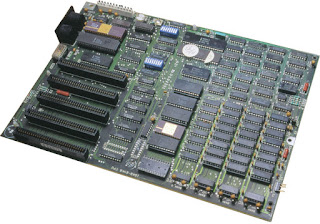BIOS
BIOS
(Basic Input Output System)
Bios or the
basic input output system is a set of programs stored inside a PROM chip and
put on the motherboard. The main job of the program stored into this ROM is, as
its name suggests is to provide the computer user the
set of standard routines, to take care of input/output from the front input,
output and the storage devices connected to the computer. This BIOS ROM is
always available in the computer. So any user program can access these routines
for their input/output requirements. The first PC BIOS was made by IBM for
their PC range of computers.
A PC system
can be described as a series of layers-some hardware and some software-that
interface with each other. Figure shows the four layers in a typical PC. The
purpose of the layered design is to enable a given operating system and
applications to run on different hardware. Fig shows how two different machines
with different hardware can each use different sets of drivers (BIOS) to
interface the unique hardware to a common operating system and applications.
Thus, two machines with different processors, storage media, video display
units and so on, can run the same OS and applications.
In this
layered architecture, the application software program talk to the operating
system via what is called an application programming interface (API). The API
varies according to the operating system you are using and consists of the
various commands and functions the operating system can perform for an application.
The application is completely insulated from the hardware, so you can run the
same applications on different machines; the application is designed to talk to
the operating system rather than the hardware. The operating system then
interfaces with or talks to the BIOS or driver layer. The BIOS consists of all
the individual driver programs that operate between the operating system and
the actual hardware. The operating system never talks to the hardware directly;
instead, it must always go through the appropriate drivers. This provides a
consistent way to talk to the hardware. It is usually the responsibility of the
hardware manufacturer to provide drivers for its hardware. Because the drivers
must act between both the hardware and operating system, the drivers typically
are operating system specific.
Motherboard
ROM BIOS
The
motherboard ROM contains a collection of programs embedded in one or more
chips, depending on the design of your computer. That collection of programs is
the first thing loaded when you start your computer, even before the operating
system. The BIOS in most PCs has four main functions:
1. POST (Power-on self test)
The POST tests your computer’s processor, memory, chipset,
video adapter, disk drives, keyboard, and other crucial components.
2. Setup
The system configuration and setup program is usually a menu-driven
program activated by pressing a special key during the POST, and it enables you
to configure the motherboard and chipset settings along with the date and time,
passwords, disk drives and other basic system settings. You can also control
the power-management settings and boot drive sequence from the BIOS setup, and
on some systems, you can also configure CPU timing and clock multiplier
settings. Newer systems use a Windows-based application to access BIOS setup
settings.
3. BSL (Bootstrap loader)
A routine that reads the first physical sector of various disk drives
looking for a valid master boot record (MBR). If one meeting certain minimum
criteria is found, the code within is executed. The MBR program code then
continues the boot process by reading the first physical sector of the bootable
volume, which is the start of the volume boot record (VBR). The VBR then loads
the first operating system startup file, which is IO.SYS (DOS/Windows), ntldr
(Windows NT/XP), or bootmgr (Vista), upon which the operating system is then in
control and continues the boot process.
4. BIOS (Basic input/output system)
This refers to the collection of actual drivers used to act as a basic
interface between the operating system and your hardware when the system is
booted and running. When running DOS or Windows in Safe mode, you are running
almost solely on ROM-based BIOS drivers because none are loaded from disk.



Comments
Post a Comment